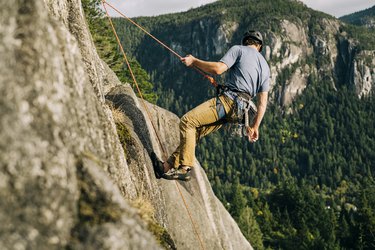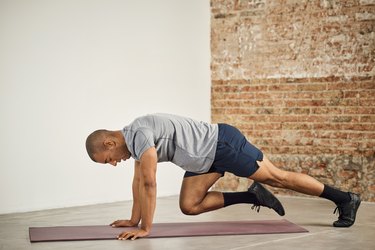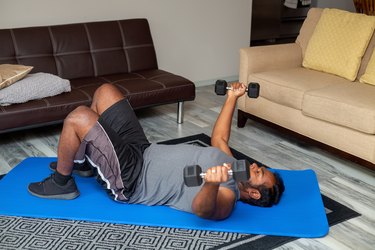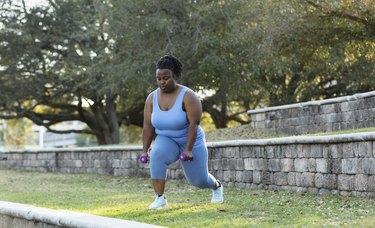
Whether you're scaling rock faces outdoors or climbing routes at the gym, climbing is a thrilling, exciting workout that involves both the body and mind — and is good for both.
Rock climbing isn't only great physical exercise, but some studies suggest that it can be therapeutic, as well.
Video of the Day
Video of the Day
An August 2015 study in BMC Psychiatry found that an eight-week rock climbing program had positive effects on those suffering from depression, and the researched concluded that rock climbing via a structured program may improve mental health.
When you use multifaceted movements to scale a climbing wall, you might notice that your heart rate is elevated and your muscles are burning. So is rock climbing an exercise that requires more cardio fitness or strength — or both?
Rock Climbing as a Workout
Chicago-based routesetter (a person who creates indoor climbing routes) Juan Guardiola of Movement Gyms has been climbing for the better part of a decade and is familiar with the type of strength and fitness needed to successfully start rock climbing.
"I see rock climbing as a hybrid of both strength and cardio fitness," Guardiola says. "In order to physically climb, you need to have muscular strength, but if you want to attempt multiple tries at a route or feel calm and confident while on the wall, good cardio fitness is important, too."
An October 2018 meta-analysis in the Iran Journal of Public Health found that rock climbing "significantly improved" college students' handgrip, lower limb pedaling power, vertical jump, push-ups, pull-ups, sit-ups and VO2 max — that's improvement in strength and cardiovascular metrics.
Guardiola also notes that having a mix of strength and cardio fitness can aid in recovery from climbing, too, leaving you with increased energy for more days to climb or participate in other fitness activities.
Muscular Strength for Rock Climbing
Rock climbing is a total-body sport, meaning it requires all of your large muscle groups in order to perform its movements accurately and without pain or injury.
Indoor rock climbing involves using your core, upper body and major leg muscles to both keep you stable on the climbing wall and pull you from hand-hold to hand-hold.
"When you're climbing, you're almost always doing a pulling motion to pull yourself from hold to hold," Guardiola shares. "It's key to balance out your body by incorporating opposing strength moves, too, such as push-ups, to prevent strain on any one particular muscle group."
Guardiola also says that having a strong core is one of the most important parts of being a competent climber. A stable core, including both the abdominals and lower back muscles, provides a solid foundation from which your arms and legs can operate. An activated core can also prevent low back and hip injuries.
Climbing also requires strength in a unique set of muscles: your fingers.
"Finger and forearm strength are unique to rock climbing, but are essential to progress in the sport," Guardiola says. "Finger strength is super important and can be trained using a hangboard, which is literally a board where you practice hanging your body weight using your fingers."
For those looking to increase their total-body strength while learning how to move their body in an intentional way, rock climbing could be the ideal activity.
Cardio Fitness for Rock Climbing
Although less obvious than muscular strength, having a fit cardiovascular system is a benefit for rock climbing, too.
Muscular strength allows you to move from grip to grip on a rock wall, but it's cardio endurance that helps you climb for longer and recover faster after each climb.
"A background in endurance sports or sports that require a lot of aerobic fitness is a great asset for rock climbing," Guardiola says. "When I worked on my cardio fitness, I was able to take more attempts at a route without getting winded, and I recovered faster after each climbing session."
Rock climbing may not look similar to running, cycling or other typical cardio-based activities, but hanging on a wall and manipulating your bodyweight can quickly raise your heart rate due to the muscular activation involved.
Improving your cardiovascular fitness will keep your heart rate steady as you move through a route and make basic reaches and grips less taxing. A robust cardiovascular foundation will also allow you to breathe steadier as you climb, which will help you to stay calm and focused — two necessary components to being a skilled climber.
Fitting Climbing Into Your Schedule
If you're not ready to climb outdoors, there are thousands of climbing gyms across the United States that welcome newcomers, and there are plenty of other fitness activities you can do in between climbing sessions that are beneficial for your time on the wall.
Guardiola says that ideally, what a new climber needs to do to become a better climber is just that: Climb as much as possible. Getting to the climbing gym a few times a week is a great baseline, and don't be afraid to let a gym know you're new to the sport.
"Be completely transparent with the front desk at your local climbing gym that you're new to the sport, and nine times out of ten, they'll have gear for you to rent and will provide you with a video or in-person course that teaches you the basics of climbing etiquette and safety measures," Guardiola says. "A lot of climbing gyms also have specialty community climbs, such as times at the gym set aside for a women's climbing group, or an LGBTQ+ climbing group."
Investing in a hangboard to have at home can be a great way to strengthen your fingers and forearms on the days you can't get to the gym. Start small and work your way up to holding yourself on the board for longer periods of time.
Push-ups and pull-ups are two other low-budget, at-home ways to build your strength for climbing. The same goes for weighted squats, planks and lunges. These can be done while watching TV, in between chores, or while listening to your favorite podcast.
Regular running, CrossFit classes and even jumping rope are also good ideas to boost your cardio health while building muscular endurance and core stability. When you do get to the climbing gym or local crag, you'll have built some foundational strength and aerobic fitness for indoor rock climbing.
In addition to a mix of both strength and cardio, Guardiola says there is a third component to being a successful rock climber: nutrition.
"I hit a point a few years ago where I was hitting a plateau with rock climbing despite being flexible, strong and cardiovascularly fit," Guardiola says. "I realized I wasn't eating enough or correctly to support the dynamics of this sport, so it's important not to forget to fuel well as a climber, too."





